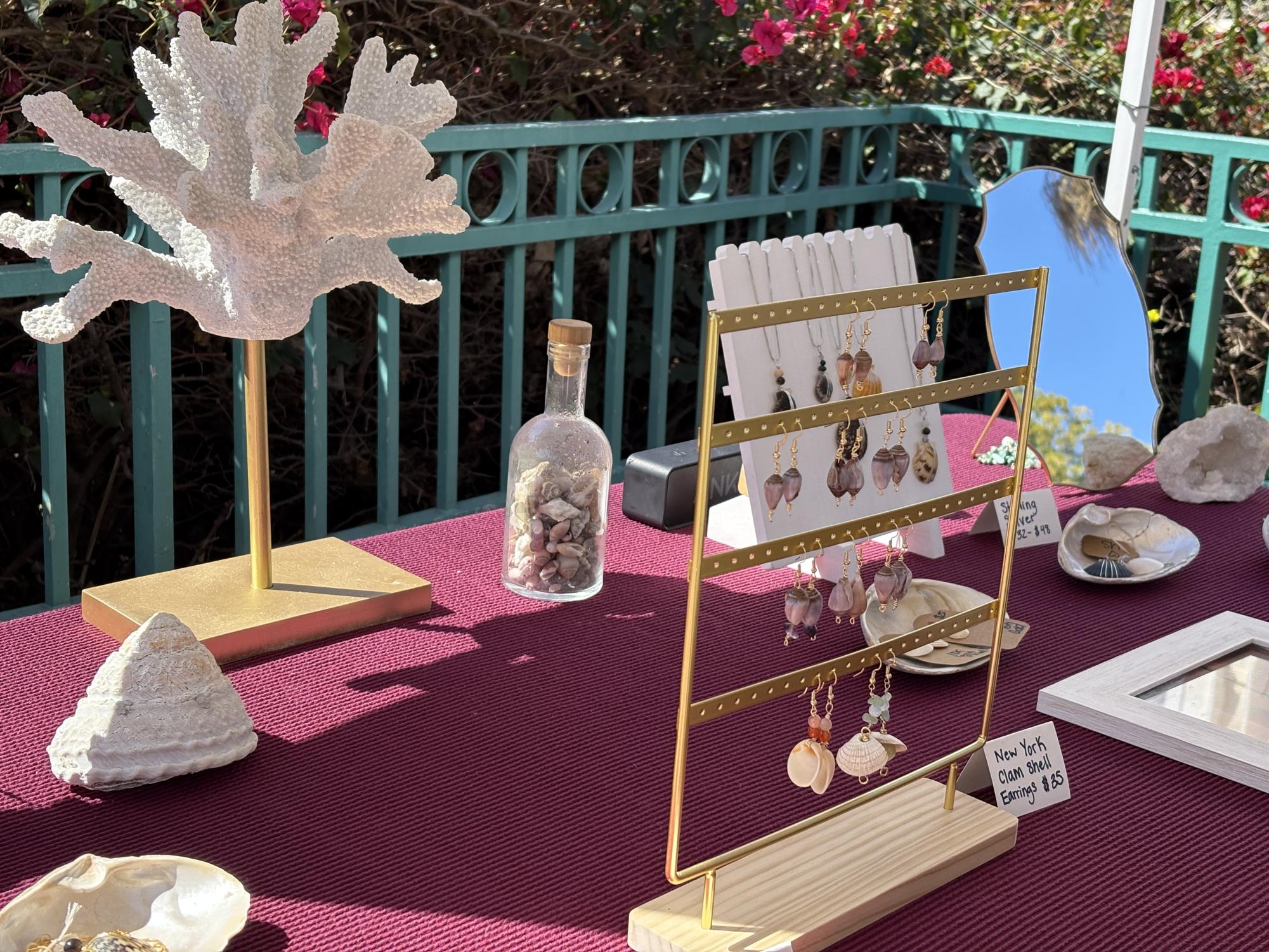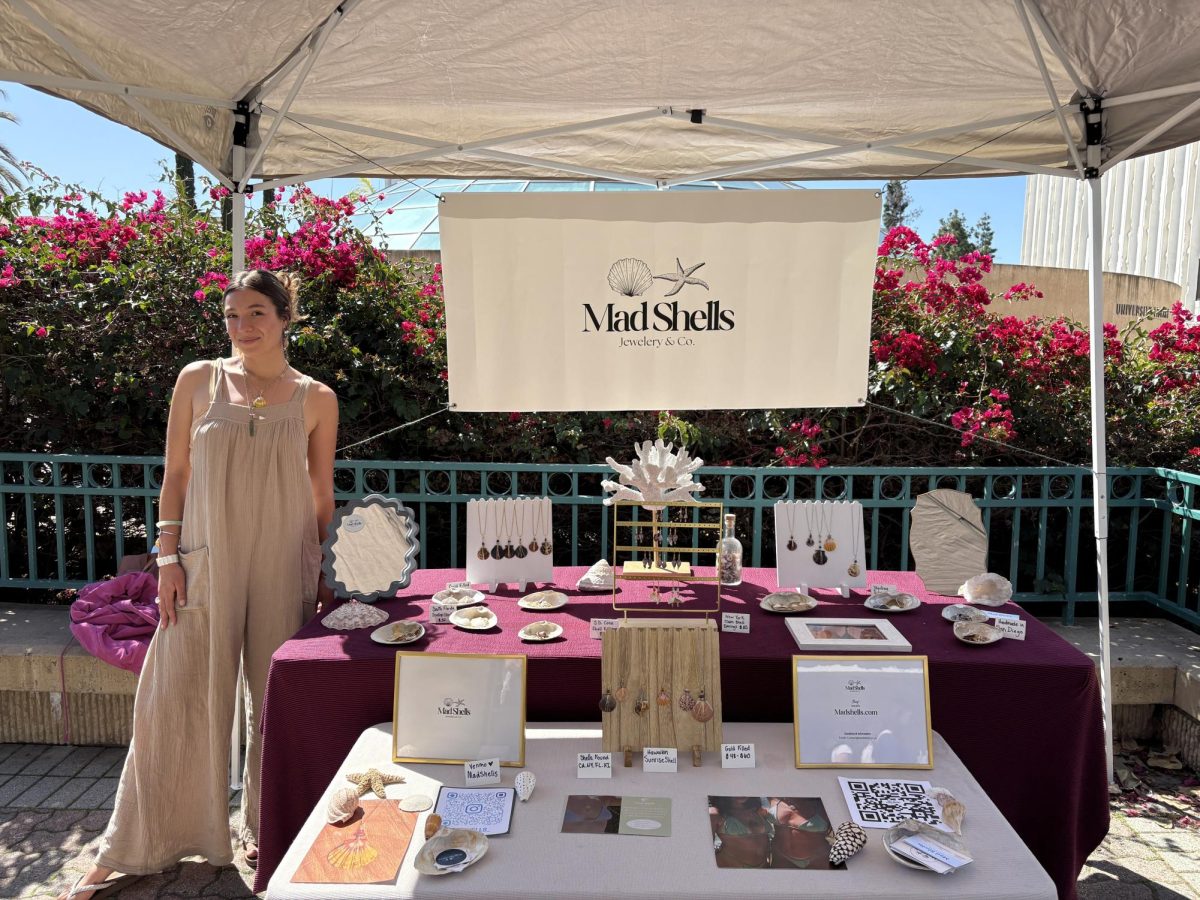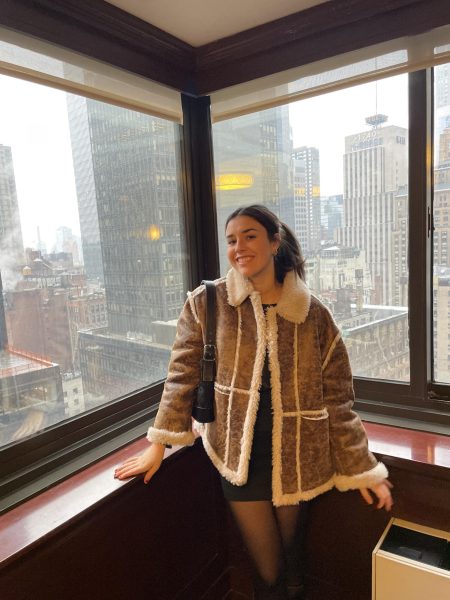It’s an early afternoon at San Diego State University, but with the sun streaming through the second floor of the student union, it might as well be summer. Madison Feinstein looks the part– wrapped in a custom Mad Shells linen button-up, her signature sunrise shell necklace resting at her collarbone and a new addition: homemade bangles. Even her green and white floral pants feel like a nod to the ocean.
A lot has happened since the last time we spoke. Over the past two months, Feinstein has been busy with future events lined up at JuneShine’s tasting room and private showcases that include exclusive jewelry making. But building a business from the ground up as a full-time college student? Not exactly an easy ride, especially during her last semester at SDSU.
“I don’t necessarily want to do product selling or marketing, really,” Feinstein says, pushing back her new bangles. “I like to do things like this– be in magazines, have Mad Shells always there at the forefront.”
So, in true Feinstein fashion, she’s here to spill on the laughable disasters, the hard-earned lessons and the reality of starting a business with nothing but a vision and a whole lot of seashells. Five months in, she’s sharing how to not start a business.
August: The first attempt
“I just came back from a family trip with Zach, my boyfriend,” Feinstein says, leaning back as she recalls the moment. She had just made her first-ever sale, and the next step was obvious– she needed to start selling. “I always see people selling and creating on that strip in Ocean Beach. Not the OB market, just that one area where you can get fun things on a random Tuesday.” It seemed like the perfect place to start.
With her boyfriend by her side, they packed up her jewelry, found an open spot and set up a table (a process that took nearly an hour). But, something about it felt off. The two of them sat there, heads down, making jewelry in silence, not really engaging with the people around them. “And then there would be groups of these very interesting individuals just meeting up in front of the table.”
At first, it was little things…people loitering, exchanging cryptic words. Then, a couple walked up and started muttering, ‘rocks, rocks, rocks.’ When a man approached, glass pipe in hand asking for even more rocks, it clicked.
“I was like ‘Oh my, we’re not like at a regular farmers market setup.’ It was a cover for people to sell drugs. And I’m there actually trying to sell shell jewelry,” Feinstein reveals. That was their cue to leave.
The lesson was most definitely learned. “The lesson there was that you can do it, you just need to do more research beforehand,” she explains. Research is often overlooked, but it truly might be the most important step for actually going out in the world and selling. Research what’s best for you and your brand, not what everyone else is doing.
Feinstein’s takeaway? “Be safe, listen to your gut, do your research. Going slow doesn’t mean you are slow, it means you’re thorough.”

October: The reality check
By October, Feinstein was doing markets nearly every weekend. But it was fall, so farmer’s markets were harder to get into and more expensive. She found an Encinitas vintage market, and with her love of North County, she was in. The fee was medium for her at $75 and she was selling at least one sunrise necklace at a market so this seemed like a good move. (For context, she recently tabled at SDSU for $300, the most she’s ever paid, even as a student running her own business).
The problem? Feinstein arrived and it was all vintage clothing. The crowd was looking for rare Levis and thrifted purses, not her gold-plated shell necklaces in the middle of autumn. It was a lesson in knowing the difference between fun events and your events. Just because an event sounds fun doesn’t mean it’s going to be the right fit for you. Markets require a full-day commitment: 7 a.m. setup, 4 p.m. breakdown, so if it’s not a good fit, it’s not worth the stress.
That mindset shifted how she approached markets. “For my SDSU table, yeah, it’s $300, and I’m spending another $300 on materials, so it’s like 600 bucks plus time. I need to make it back tomorrow. But if I don’t, I don’t care because I’m a senior, this is fun, my friends are coming, I’m getting my name out there and I won’t be able to sell as a student ever again, ” Feinstein explains.
For Feinstein, the biggest lesson was to find the good in everything. “The Encinitas market was a total fail, but I met a PR woman from SunBum who ended up gifting me products months later at my first event,” she says, smiling.
Sometimes, the best things come from what you don’t expect.
September: The shoot that almost didn’t happen
Sticking to her mindset of staying positive, Feinstein took a chance. She approached a swimwear and activewear brand she had always admired, introducing herself on a whim. To her surprise, the owner invited her to feature her pieces in an upcoming photoshoot– a dream opportunity for a new small business. So, Feinstein immediately began planning lookbooks and selecting the perfect pieces.
The plan was a stunning cliffside shoot, but the reality was chaos…
“It’s just me and this model, and the location changes last minute. Same issue, different cliffside: the tide is too high, and no one wants to shoot,” she remembers. Feinstein found herself literally standing on a cliff, arms full of Mad Shells jewelry, trying to make it work. Then, things took a turn.
“Maria, the woman who invited me, fell. She ended up being okay, thank God, but what were the odds?” On top of that, the camera got wet,” Feinstein continues. “The shoot wasn’t happening as planned.”
Feinstein reminded herself to set boundaries: research first, and not always sacrifice for others. She had missed class and taken time off work, things she couldn’t really afford. Still, she made it work, adjusting the shooting schedule. The silver lining? She built valuable connections, including a lasting friendship with the model.
“If you have the right attitude, something positive will come out of it,” Feinstein says, offering advice to new businesses. “You can learn from the disaster. I mean, now I do my own content.”

November: Finding the balance
Running a business out of your home is one thing…running it out of a shared space with roommates is another. For Feinstein, that meant learning how to separate Mad Shells from Madison.
“I love to say, ‘I’m not Mad Shells, I’m Madison,’ and my roommates get it because I’m sharing a space with them. But like, my garage is completely taken over.”
That separation became crucial, especially on tough days. “When I’m feeling defeated, I remind myself– Madison doesn’t care. And it’s good to have that mindset because, like I said, longevity is important too. If you want to keep enjoying it, it can’t become your entire life,” she explains.
At the start, Feinstein was just “the shell girl.” And, she still is just with a business now. But learning how to switch off, to create boundaries between work and life, is what’s keeping her passion alive. “I can’t be MadShells all the time.”
December: Owning it
December was the month it all clicked. “I realized I could do this business all by myself,” Feinstein says. There wasn’t a single defining moment, just a growing understanding that confidence, time and reliability are the keys to success. You are enough.
With Mad Shells, reliability is everything. “I never want anyone to second-guess my products or feel scammed,” Feinstein says. “If I’m selling you a $50 necklace, know that it’s gold-filled, handmade and I sourced the shell myself.”
She also learned that not everyone will share her vision– and that’s okay. “A lot of people will tell you when you first start to look at other brands, sources or influencers to model and replicate. And yeah, that’s how some brands grow fast, hopping on trends, but that’s not what I want to do.” Feinstein says.
Authenticity is the foundation of Mad Shells, and she wants to build a brand based on her ideas, thoughts and audience, even if not everyone will get it. “People say they love my jewelry but that it’s not ‘everyday jewelry.’ That’s okay, Mad Shells isn’t meant to be,” she adds.
But “everyday jewelry” is subjective, and by the way, Feinstein absolutely owns the full shell look, from wrists to ears.
Her biggest realization was that just because no one else is doing something doesn’t mean it’s wrong. Mad Shells isn’t for everyone, and that’s exactly the point.
Where Mad Shells is now: The planning era
Every month has been a lesson: sales, strategies, marketing, figuring out what works and what doesn’t. “Coming out of the winter season, I learned that jewelry-making events are a winter thing,” Feinstein says. “And that I need to work markets in the summer because outreach is super important for small business.”
Now, she’s in her planning era: private events for summer, more public ones for winter. It’s all about strategy– building Mad Shells with intention, learning from the past and setting herself up for what comes next.








